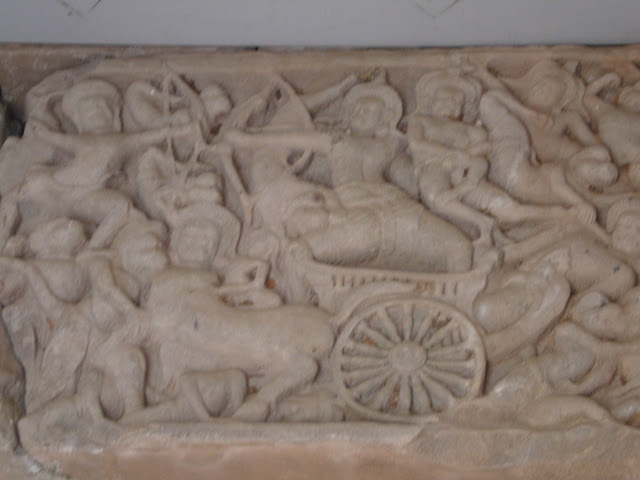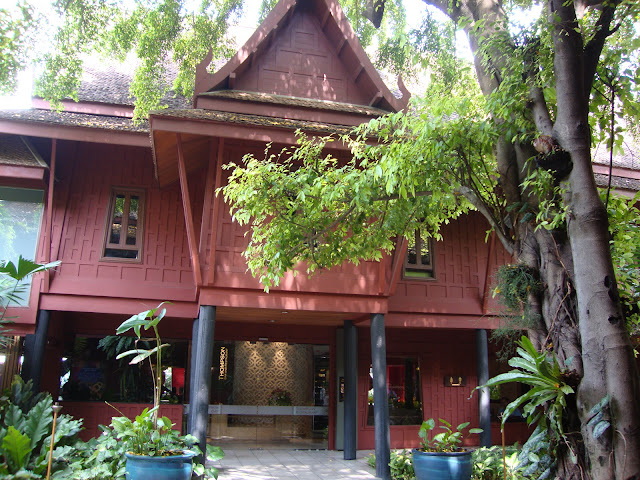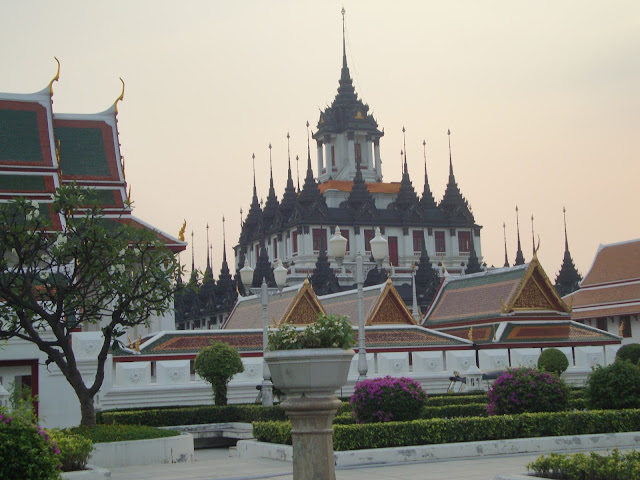Phimai
I had to wait a whole day for a sleeper on the train back to Bangkok from Utaradit. Why Utaradit? Well I had gone to Sawankalot in order to see the ruins at Si Satchanalai, thinking that I could get a train from Sawankalot to Bangkok, but the only train travelled overnight without sleeping compartments. I spent an hour and a half in the station master’s office in Sawankalot, trying to make myself understood by pointing to dates on the calendar, pointing to times on the train timetable, drawing pictures of beds and bunks on trains and eventually managed to book a ticket on the sleeper from Utaradit to Bangkok a day later. So I caught a bus to Utaradit, after spending the morning replacing my computer charger. I arrived in Utaradit bus station and began asking for the train station, to be met with blank stares. No English. So I pointed to the rail track, marked on a map and someone understood and took me to the station. At the station I pointed at my luggage. People pointed to a stall selling biscuits and crisps. I went over. The woman pointed to the floor inside the stall. I took my luggage behind the stall, she gave me a ticket, I took money out of my purse and she took twenty baht off me.
I left the station in search of food. Markets in Thailand are either very early in the morning, after dark, or indoors. I found an indoor market and wandered about until I found a stall selling green papaya salad. The woman making the salad picked up a big, red chilli. I shook my head. She picked up two cloves of garlic. I shook my head. I nodded to all the other ingredients: peanuts, fish sauce, honey, lime, tomato and some other unrecognisable vegetables. She pounded it all in her pestle and mortar with the finely sliced green papaya. Then she dipped a spoon in and passed it to me to taste. I nodded and passed her a plate. I added dried miniature shrimps. She smiled as she watched me eat.
Deeper into the market I came across a woman selling banana cake. She may only have known two words in English, but those two words were Banana Cake. So I bought a piece and ate it there and then at her stall. She invited me to sit with her for a chat, despite the fact that I only know about two words in Thai. She and her neighbour stallholder were laughing about their “falang” (foreigner). They taught me ‘aloi’ – to like and fed me lychees. We exchanged gestures about getting fat eating cake. They laughed.
Later in the station someone stole the cover of my Kindle and the lead that connects it to my computer. Why? Exchanging stories with fellow travellers days later I discovered that people had had the most bizarre things stolen – e.g. swimming trunks!
The station master was careful to see that I waited in the right place for my train carriage and that I caught the right train. I climbed into my bunk, ate a tin of tuna that I’d been carrying around for a month, washed down with a can of beer and slept fitfully until the men who change the sheets came round at about five am, shouting to wake us up.
We arrived in Bangkok at six am and I bought a ticket to Nakon Ratchasima, which for some inexplicable reason is also called Korat. It was one of those trains with open windows that the smoke from the engine blows into. The ticket puncher/guard and I were wearing cotton masks. After three hours we went through some beautiful hills, covered in thick jungle. The pyromaniacs didn’t seem to have reached this part of Thailand yet. Everything was lush and green. The train laboured up through the hills, down the other side and then ran along beside them for some time. We went past a big lake. The ticket puncher/guard was keen to point it out to me. The teak trees were busting into leaf after their short leafless period (you can’t really call it winter). At 11.30 an army of lunch vendors invaded the train with all the usual pork and chicken offerings. Half an hour later they all left.
The slow train cost two pounds. The motorbike taxi from the train station to the bus station cost one pound. I caught a bus to Phimai, checked into the only guest house I could find, looked for lunch but didn’t find any, then retired to my dormitory bed to read until the sun went down a bit.
That evening I found a restaurant with a menu in English, down a little back street. I was soon joined by a Belgian man who told me about Phanom Rung, the next place I want to visit, which apparently is very difficult to get to. He said there was no public transport to get there, so he hired a motorbike. Well I’m not going to do that. We went back to the hotel and continued to chat on the terrace, where a group of very serious Germans were playing cards. I was glad to have someone to talk to after several days communicating with gestures.

I went to see Prasat Phimai (Phimai temple) in the soft, early morning light. There were about three of us there at that time. This is one of the biggest temple complexes in Thailand, built out of stone, like the Khmer temples in Cambodia. Many of the designs sculpted on the stonework depict ancient Hindu texts, like those on the walls of Angkor Wat. The whole complex reminds me of Angkor Wat, but predates it by at least a hundred years. The main Prasat (central building or tower) was built of huge blocks of white sandstone, carted from the mountains by elephants, or floated down rivers on rafts. Over the centuries black mould has discoloured this Prasat, but it remains beautifully carved. Other parts of the complex were built in red sandstone. Only a few structures are made of ugly black laterite.
Trees sprout out of huge piles of stones where parts of the temple complex have collapsed. Apparently reconstruction is taking place, but I didn’t see anyone working on it.
Four outer buildings point towards the central Prasat, their central corridors framed by a series of doors perfectly aligned and all focussed on the central space inside the main Prasat. The antechamber to the main Prasat has a stone roof, miraculously still intact, with carved nagas (river serpent gods) at the corners. Workers sweep and rake the grassy lawns that stretch between the different parts of the temple complex. Dappled light filters through the big old trees. This is a tranquil oasis in the middle of modern Phimai town. It was definitely worth coming all this way to see, I thought. So completely different from Ayuthaya and Si Satchanalai, so much more like Cambodian Khmer temples.
There is a holy water conduit that passes through the floor of the main Prasat to outside. It is my guess that a lingam stood at the centre of the Prasat, kept bathed in water. This would have been replaced by the Buddha statue that now sits in the central place.
Buddha statue with many-headed serpent protecting his head. A pigeon perches on the serpent
Several inscriptions in Cambodia refer to a town called Vimai or Vimayapura. This later became Phimai. Vimai/Phimai was an important centre of the ancient Khmer Kingdom and was prosperous and glorious in the 12th century. Several Khmer kings lived there, up until the Ayuthaya takeover, including King Jayavarman VII. In the 13th century he built seventeen shelters and some hospitals along the routes from Angkor to Phimai, for travellers. He also transferred a Buddha image from here to Angkor.
The visitors’ centre at Phimai states that Prasat Phimai was built as a Buddhist temple. Clearly this is not true. It is covered in Hindu carvings, much like Angkor wat and it was built as a miniature universe on earth in the Hindu tradition. Hindus believe that there are deities in Heaven and people live on the earth, so they create temples to link the worlds of the gods and men. It is known that there was a lingam in one of the buildings, though no one will admit that there could have also been one at the centre of the main Prasat. All over the Khmer empire Hindu temples were converted to Buddhist ones and vice versa, as the different Khmer rulers tried to impose their different religions. Phimai was part of the Khmer empire so it stands to reason that it could have undergone a similar conversion. It probably became a Buddhist temple in the 13th century, when King Jayavarman VII installedthe bronze Buddha statue. The visitors’ centre also says that Prasat Phimai was the model for Angkor Watt but they have no evidence for this. There are some Buddhist sculptures on Prasat Phimai but there are also Khmer dancing girls and scenes from ancient Hindu texts.

































